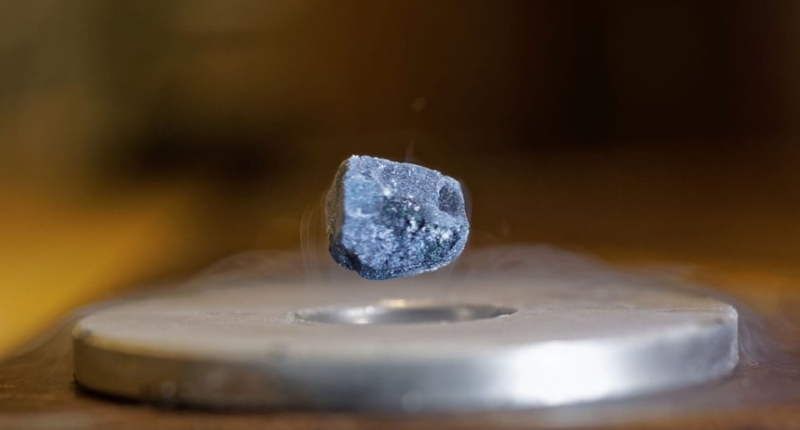Superconductors are materials that conduct electricity without any resistance, making them highly efficient. They work by having electrons move in a coordinated way and get passed along from atom to atom without collisions with the nuclei of the material. The colder a material gets, the more organized the movement of electrons and nuclei becomes. Room-temperature superconductors could revolutionize electronics, making wires and circuitry more efficient and producing far less heat. It could increase the density of wires in a circuit, leading to faster and cheaper electronics. Moreover, if the wires used to transmit electricity were replaced with superconducting materials, these new lines could carry up to five times as much electricity more efficiently than current cables. Superconductors could also lead to magnetic levitation for energy storage devices or trains, potentially revolutionizing transportation systems. Recent advances in superconductivity research have provided exciting news for researchers and technologists alike.
Understanding Resistance-free Electricity in Superconductors
Electricity is the backbone of the modern world, powering every electronic device from cellphones and computers to heating systems and televisions. However, about 5% of the power generated at coal or solar power plants is lost during transmission, amounting to a loss of USD 6 billion in the U.S. alone. This is where superconductors come into play.
Superconductors are materials that conduct electricity without any resistance to the flow of electric current, making them highly efficient. Copper or aluminum wires, on the other hand, generate heat when current passes through them due to resistance. This is similar to sliding your hand over a rough rug versus a smooth surface. The rug generates more friction and, therefore, more heat.
Superconductors are also unique in that they repel magnetic fields, resulting in the levitation of magnets above a superconductor. As a physicist who investigates how superconductors work at an atomic level, I am thrilled by recent progress toward developing superconductors that function at relatively normal temperatures and pressures.
What Are Superconductors?
A superconductor is any material that conducts electricity without offering any resistance to the flow of the electric current. Superconductors are made of electrically neutral materials, meaning that their atoms contain negatively charged electrons surrounding a nucleus with an equal number of positively charged protons.
How Do Superconductors Work?
The key characteristic of superconductors is their resistance-free attribute. Unlike standard conductors like copper or aluminum, superconductors don’t heat up when current passes through them, making them highly efficient. Superconductors also repel magnetic fields, causing magnets to levitate above them.
The zero-resistance property of superconductors is due to the fact that electrons form pairs that move together without any resistance. This phenomenon is known as Cooper pairs, named after American physicist Leon Cooper, who first theorized their existence in 1956. Cooper pairs can only exist at very low temperatures, typically below -100°C.
Advancements in Superconductors
For years, scientists have been working on developing superconductors that can function at relatively normal temperatures and pressures. Recent progress in this area has been significant, offering exciting prospects for the future. With nearly 100% efficiency, superconductors have the potential to revolutionize power transmission and storage systems, leading to significant energy savings and environmental benefits.
In conclusion, superconductors offer a resistance-free solution to electricity transmission, making them highly efficient and attractive for use in power transmission and storage systems. Recent developments in this field have been significant, and the future looks bright for superconductors.
Understanding Superconductivity and Its Potential Applications
When a wire is attached to a positively charged object at one end and a negatively charged object at the other, electrons begin to move in order to balance the charge. However, at normal temperatures, electrons in wires tend to move erratically and may collide with the nuclei of the material, causing resistance and heat.
Superconductors and Resistance
Superconductors are materials that conduct electricity without any resistance or heat generated. In a superconducting material, the electrons move in a coordinated way and get passed along from atom to atom without collisions with the nuclei of the material. The colder a material gets, the more organized the movement of electrons and nuclei becomes. This is why existing superconductors only work at extremely low temperatures.
Benefits to Electronics
If scientists can develop a room-temperature superconducting material, it would revolutionize electronics, making wires and circuitry more efficient and producing far less heat. Using superconducting wires in electronics could increase the density of wires in a circuit, leading to faster and cheaper electronics. Moreover, if the wires used to transmit electricity were replaced with superconducting materials, these new lines could carry up to five times as much electricity more efficiently than current cables.
Potential Applications
Room-temperature superconductors could also lead to many other applications. Magnetic levitation could be used for energy storage devices or trains, and could potentially revolutionize transportation systems.
Recent advances have provided exciting news, with researchers exploring the fundamental physics of high-temperature superconductivity and technologists eagerly waiting for new applications.
In conclusion, superconductivity is a phenomenon that offers a resistance-free solution to electricity transmission and has the potential to revolutionize electronics and transportation systems. With recent advancements in the field, it is an exciting time for both researchers and technologists alike.
Don’t miss interesting posts on Famousbio










